Abstract
Natural fibers in composite materials have received growing interest for the last decades. Few works have explored the study of long vegetable fibers reinforcing composites such as textile reinforcements to develop higher performance of bio-materials which could be used in load-bearing applications. Therefore, the identification of new natural textiles should turn into an active research challenge for use as reinforcement in the development of green composites. In this study, leaf sheaths from Cocos nucifera L. was investigated. This material presents the distinctive feature to be naturally available as a textile. Thus, coconut leaf sheath was characterized morphologically, chemically, physically and mechanically. Coconut textile displays low Helium density and water sensitivity, promising thermal stability and tensile properties in both fibers directions forming the sheath. Compared to natural and synthetic textiles, coconut leaf sheath appears as a suitable, promising and competitive textile reinforcement for the development of eco-friendly continuous fibers composites.
Keywords: Bio-textile; Vegetable fibers; Chemical properties; Physical properties; Mechanical properties
Introduction
The 20th century was marked by an unprecedented industrial growth characterized by a material prosperity and a not responsible control of nature by humans neglecting the deleterious impact of this model on environment [1]. Faced with the alarming and undeniable observation bound to global warming and natural resource scarcity, the 21st century is the bearer of many challenges being in line with a sustainable development process to resolve the current ecological crisis [2,3]. In this context, new environmental regulations [4] have been elaborated what has incited manufacturers and researchers to develop alternatives to materials made of non-renewable fossil and mineral resources.
One of these alternatives concerns the development of plant fibers composites as substitutes for synthetic fibers composites. Indeed, vegetable fibers show several advantages compared to their conventional synthetic counterparts like low cost, low density, low abrasiveness, high specific mechanical properties, abundant avaibility, biodegradability, renewability and sustainability [5-9].
Fibers length (continuous/discontinuous) and their orientation (random/oriented) are two major factors influencing mechanical composites properties [10,11]. Polymers reinforced with discontinuous fibers, generally randomly oriented to ensure mass production [12], are employed in non load-bearing structures. The development of continuous fibers composites is, however, essential to manufacture materials which can be used in structural applications [13,14,15]. These materials present higher mechanical properties in the fibers axis direction compared to non-aligned short fibers reinforced polymers [16,17]. The long fibrous reinforcements whose preferred placement is adapted to external stresses on the final piece, can be oriented in one direction or several directions. They form unidirectional and textile composites respectively [18]. Textile composites can be woven, knitted, braided or sewn [19,20]. They are known to exhibit better toughness, impact and inter-laminar shear resistance, damage tolerance, integrity and conformability than unidirectional laminates [20,21]. It is only recently that lignocellulosic textiles have been used as polymer reinforcements [22]. Their studies number is low compared to the number of works dealing with discontinuous plant fibers composites due to the innate short length of the lignocellulosic fibers [23]. To form long yarns which are interlaced to make textile structures, vegetable fibers need to be twisted [24].
In this overall context and in the continuity of these research areas falling within a sustainable development approach, this work intends to contribute to the identification of new natural textile reinforcements, and thus, to study the potential use of the leaf sheaths from Cocos nucifera L. in bio-composites fabrication. This resource, non exploited industrially until now, was chosen because in addition to be vegetable and available locally all the year. Coconut trees grow extensively in humid tropical regions where they occupy 12 303 924 ha worldwide whose 127 918 ha in the Caribbean and 85 ha in Guadeloupe [25]. A coconut tree can live more than 100 years and produces 18 leaf sheaths by year on average [26]. It shows the advantage to be a textile by nature freeing us from the interim step of reinforcement production in the form of textile. Thus, this reinforcement potential use will enable to minimize the production costs. In order to use this resource at best, coconut leaf sheath was extensively characterized by chemical composition analysis, infrared spectroscopy study, thermo-gravimetric experiment, morphological observations and physico-mechanical properties assessments (specific density, water absorption, tensile strength, Young modulus, strain and toughness). Its properties were compared to literature for other fibrous reinforcements.
Materials and Methods
Materials
The coconut leaf sheaths were collected manually from coconut trees Cocos nucifera L. in Guadeloupe, France (Figure 1). The sheaths, located at the petiole of the leaves, ensure their sticking on the pseudotrunk of coconut trees. The coconut leaf sheaths were cleaned with high-pressure water before being rinsed thoroughly with distilled water and then sun-dried for one week.
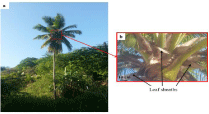
Figure 1: Pictures of a coconut tree Cocos nucifera L. in Guadeloupe (a) and
its leaf sheaths (b).
Methods of characterization
Morphology: The both faces structure of coconut leaf sheaths was observed using a binocular magnifier Nikon SMZ 1000.
A Scanning Electron Microscope (SEM) Quanta 250 coupled with an Energy Dispersive Spectrometer (EDS) were used to study surface morphology and cross section of coconut leaf sheaths fibers. Prior to the analysis of the fibers cross section, samples were coated in epoxy resin, and then polished.
Linear density: To evaluate the number of fibers for 10 cm as a function of their thicknesses, each coconut leaf sheaths face was first scanned with Canoscan 4400F and then measured with Image J software. Eight coconut leaf sheats faces were scanned three times each.
Chemical composition: Cellulose, hemicelluloses, lignins and extractives weight contents were determined according to Ouensanga and Picard methods [27]. Between two and four analysis per component were done.
Infrared spectroscopy analysis: Fourier Transform Infrared Spectroscopy (FTIR) in Attenuated Total Reflection (ATR) mode was carried out on untreated coconut leaf sheaths. IR spectra were recorded using the Bruker Tensor 27 spectrometer in the 4000-400 cm-1 region with 20 scans with a resolution of 4 cm-1. To check the results reproducibility, three analysis were performed.
Helium density: Helium density of coconut leaf sheaths was measured using a helium Pycnomatic Thermo Electron pycnometer. In this way, sheaths discs of the diameter of the nacelle were cut out. Five measurements were conducted for each sample.
Water absorption: For each sample, the coefficient of water absorption at saturation was estimated by equation 1:
| WA(%)= | Ws-Wi | X100 | equation 1 |
Where :
Ws is the weight of the specimen saturated with water (g),
Wi is the initial weight of the specimen (g).
This test was carried out immersing 20 samples of coconut leaf sheaths (13×5)cm2 in distilled water at (26±1)oC. Before testing, coconut leaf sheaths specimens were dried at 105oC until a constant weight was reached.
Thermal decomposition analysis: Thermogravimetric Analysis (TGA) was used to study the thermal degradation of coconut leaf sheaths. Thermograms were carried out using Perkin Elmer Pyris-1 TGA instrument from 50oC to 800oC at a heating rate of 10oC/min in a nitrogen atmosphere. Before testing, fibers were chopped and dried at 105oC until a sample constant weight was reached. To check the results reproducibility, three analysis were performed.
Mechanical properties: In both preferential fibers directions, coconut leaf sheaths were tensile tested at (24±3) oC and at (70±5) % relative humidity, according to ASTM D5035 method [28] using an universal machine Servohydraulic Test from System MTS Landmark equipped with a 2.5kN load cell (rate 10mm/min). For each samples set, eight specimens were tested. To prevent sliding of coconut leaf sheaths in clamping jaws, wood tabs were stuck on their extremities. For each tested direction, cross sectional area of each specimen was obtained adding up cross sectional areas of tested fibers. These were evaluated for each fiber, averaging cross sectional areas to the level and on both sides of failure zone, before the test. For each longitudinal thickness determined with Image J software, fibers cross sectional area was calculated using the equation of fibers cross sectional areas modelling displayed on Figure 2.
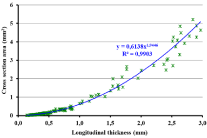
Figure 2: Modelling of fibers cross sectional areas as a function of their
longitudinal thickness.
This modelling was obtained from 180unit fibers taken out from coconut leaf sheaths. The calculation used for fibers area is the one of an ellipse (cf. 3.1.2). The longitudinal thickness was evaluated using Image J software whereas the cross sectional thickness was estimated with a sliding calliper whose precision is 0.01mm.
Statistical analysis: The mechanical properties of coconut leaf sheaths were analysed statistically using analysis of variance (ANOVA) followed by a Tukey test to detect potential differences between the two fibers directions tested. The statistical tests were carried out at 5% level of significance.
Results and Discussion
Fibrous structure and morphology
The coconut leaf sheaths observations are visible on Figures 3, 4, 5 and 6 at different scales.
Macroscopic scale: The coconut leaf sheaths present the particularity to have a symmetry axis represented in yellow on Figure 3-a. The observation of this material at macroscopic scale reveals a textile composition shaped by three collinear fibers layers:
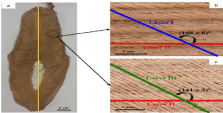
Figure 3: Pictures of a whole coconut leaf sheath (a), of its outer face (b) and
of its inner face (c).
- The outer face, exposed to the environment, is made up of the tangle of both fibrous networks depicted by layers I and II on Figure 3-b. Their architecture is similar to the one of a biaxial braid whose structure is illustrated by Denniger et al. [29]. Indeed, fibers of layer II comprising big (1 mm ‹ thickness ≤ 3 mm), medium (0.2 mm ‹ thickness ≤ 1 mm) and fine fibers (thickness ≤ 0.2 mm) are kept parallel by fine fibers of the layer I (thickness ≤ 0.2 mm) (Figure 4) which are arranged diagonally to the direction of the layer II,
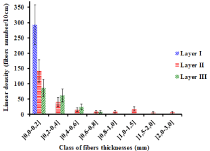
Figure 4: Linear density of coconut leaf sheaths.
- The inner face in contact with the coconut tree pseudotrunk is composed of a single layer of unidirectional fibers, the layer III (Figure 3-c), whose thickness ≤ 0.8 mm (Figure 4). The fibers of this layer are tied to the outer face by fibrous « seams ».
Fibers of layers I and III are placed at (146±8)o in relation to fibers of layer II. This structure underlines the birectional organisation of the coconut leaf sheaths whose thickness is estimated at (2±1) mm.
The number of each fibers thicknesses class is informed on Figure 4, and this, for each layer.
Microscopic scale: The SEM pictures of coconut leaf sheaths cross sections on Figure 5 show the wide disparity of fibers highlighted on Figure 4. Each fiber reveals an approximate ellipsoidal section consisting of:
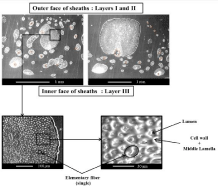
Figure 5: SEM pictures of cross sections of coconut leaf sheaths embedded
in resin.
- A central or peripheral canal whose some are circled in on Figure 5,
- A bundle of elementary fibers bound together by an intervening layer, the middle lamella, consisting of lignins mainly [30]. The single fibers demonstrate homogeneity in their shape, rather ellipsoidal and in their dimensions : their cross sectional area is about (200±100) μm2 ; they have a cell wall around (5±3) μm of thickness which surrounds an hollow space in their center, the lumen [31,32] whose diameter is (10±4) μm approximately.
Fibers surface of coconut leaf sheahts is illustrated on SEM pictures on Figure 6. It is characterized by the presence of many cavities spread uniformly, giving to the surface a rough feature. The surface roughness of coconut leaf sheahts should improve the fiber/ polymer adhesion by an increase of mechanical interlocking at the fiber/matrix interface and of fibers contact surfaces with the resin [6,33].
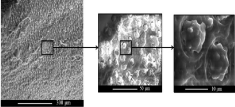
Figure 6: SEM images of surface morphology of coconut leaf sheaths fibers.
Besides, grained protusions are noticed in numerous cavities; they are made up of silicon essentially, according to EDS analysis not shown here.
Chemical analysis
The chemical composition of leaf sheaths from Cocos nucifera L. compared to the ones of vegetable fibers commonly used as reinforcements is presented in Table 1.
Fibers
Cellulose (weight %)
Hemicelluloses (weight %)
Lignins (weight %)
Extractibles (weight %)
References
Coconut leaf sheath
39.22±1.45
22.17±3.91
29.62±0.74
0.81±0.06
Present study
Flax
64-76
17-21
2-3
2-3
Hemp
70-75
18-22
4-6
1-2
Sisal
65-66
12
10
1
Jute
61-72
12-20
13-Dec
0.7
[60,61,32]
Cotton
83
6
-
6
Kenaf
72-53
20-34
21-Sep
-
Ramie
69
13
1
2
Banana
60-65
19
5-10
5
Bamboo
74
12
10
3
Abaca
56-63
20-25
7-9
3
Coir
32-43
0.2-0.3
40-45
-
Oil palm
56-65
28
19-20
4
Tururi
57
12
31
-
Table 1: Chemical composition of coconut leaf sheaths compared to those of plant fibrous reinforcement.
The major botanical component of leaf sheaths is cellulose making them interesting potential candidates as polymers fibrous reinforcements. Indeed, cellulose provides strength and structural stability to the fibers owing to its semi-crystalline structure in the form of microfibrils constituted by hydrogen bonds between its glucose units [34]. The cellulosic reinforcing elements are embedded in an amorphous matrix composed of lignins, hemicelluloses and extractives mainly, the whole forming the plant cells wall [35].
The extractibles are constitued of waxes, fats and terpenes primarily, being removed from fibers by an organic solvents mix made of ethanol and toluene [36]. This component is in very low proportion in coconut leaf sheaths, present also in minority in other lignocellulosic fibers (Table 1).
The noticed hemicelluloses content is similar to the ones of most classic vegetable reinforcements (Table 1). The hemicelluloses, highly hydrophilic, should harm compatibility between fibers and most polymers which are hydrophobic, causing the decrease of composites mechanical properties [37,38].
The lignins percentage in leaf sheaths is of the same order of magnitude as the ones of fibers from other palm trees (oil palm, tururi) or other parts of Cocos nucifera L. such as coconut husk (coir). Nevertheless, lignins are less numerous in the other fibrous plant reinforcements (Table 1) predicting a better stiffness of coconut leaf sheaths fibers [39]. Besides, this stiff wall component prevents cellulose fibrils from reorienting in the load direction limiting the stress transfer [40].
However, improvement of fibers mechanical properties and fiber/polymer compatibility can be achieved by chemical, physical or biological treatments [41,42].
The additional non dosed part (8.18%) should correspond with pectins and inorganic constituents such as minerals [43] which are lesser components than cellulose, lignins and hemicelluloses.
Infrared spectroscopy
The infrared spectrum of coconut leaf sheaths is shown in Figure 7. The observed absorption bands are characteristic of the main lignocellulosic components of plant fibers (cellulose, hemicelluloses and lignins) constituted primarily by alkenes, ester, ketone, alcohol and aromatic groups.

Figure 7: FTIR spectrum of coconut leaf sheaths.
The broad peak at 3340 cm-1 is characteristic of the hydrogen bonded O-H stretching whereas the absorption band at 2890 cm-1 corresponds to alkyl C-H symmetric and asymmetric stretching. Besides, the band at 1729 cm-1 can be attributed to C=O elongation of hemicelluloses carbonyl groups. The presence of moisture in leaf sheaths may be reflected in the peak at 1598 cm-1 in addition to the one at 3340 cm-1. The C=C stretching absorption of lignins aromatic skeletal appears at 1505 cm-1 which can be also assigned to proteins. The milder peaks at 1453 cm-1 and 1422 cm-1 could be associated with the CH2 and CH3 bendings in cellulose and lignins respectively. In addition, the absorbance at 1368 cm-1 belongs to cellulose C-H vibrations. The well-defined peak at 1236 cm-1 corresponds to C-O stretching of acetyl groups in lignins and hemicelluloses. At 1154 cm-1 and 1030 cm-1, the absorptions are attributed to cellulose C-O-C and C-O stretching vibrations. The small peak at 898 cm-1 is due to vibrations of holocelluloses β-glycosidic bonds [44,45].
The FTIR spectrum obtained for coconut leaf sheaths shows a similar trend to the ones of other plant fibers [46,47].
Physical properties
Table 2 displays the Helium density and the water absorption coefficient found for coconut leaf sheaths and reported in literature for ordinary natural and synthetic fibrous reinforcements.
Fibers
Helium density (g/cm3)
References
Saturation water absorption coefficient (%)
References
Coconut leaf sheath
0.97±0.01
Present study
95±13
Present study
Flax
1.4-1.5
[62,63,9]
-
Hemp
1,5
160
[64]
Sisal
1.3-1.5
175-230
[65,66]
Jute
1.3-1.5
281
[67]
Cotton
1.5-1.6
-
Ramie
1.5
-
Banana
1.4
407
[68]
Bamboo
0.6-1.25
-
Kenaf
1.2-1.5
285
[67]
Coir
1.2-1.5
100-127
[65,66]
Oil palm
0.7-1.6
-
Date palm
0.7-1.2
133
[69]
Tururi palm
1
70-74
[60]
Glass
2.5
-
Aramid
1.4
-
Carbon
1.4
-
Table 2: Physical properties of coconut leaf sheaths and other lignocellulosic and synthetic fibers.
Coconut leaf sheaths indicate a lower density than most wellestablished plant (flax, hemp, sisal, jute, cotton, ramie, banana, kenaf, coir) and synthetic fibers (glass, aramid, carbon) usually used as reinforcement in polymers. Therefore, compared to these fibrous reinforcements, coconut leaf sheaths present the advantage of reinforcing more lightweight eco-friendly composites for the same fibers volume fraction.
Moreover, coconut leaf sheaths absorb less water at saturation than hemp, sisal, jute, banana and kenaf. Nevertheless, their ability to absorb water is comparable to the one of fibers from plants of the same family such as date palm, tururi palm or from other parts of the coconut tree like coconut husk for coir fibers. These observations could be correlated partly to the lignins content, similar in coconut leaf sheaths, palm trees and coir fibers but higher than in hemp, sisal, jute, banana and kenaf, as presented in 3.2. Indeed, lignins have an hydrophobic nature due to their complex and random structure made of hydrocarbons [48] and their low –OH-to-carbon ratio [9]. In addition, the lower water sensitivity of coconut leaf sheaths compared to hemp, sisal, jute, banana and kenaf should lead to a better dimensional stability of coconut leaf sheaths reinforced composites given the decrease of the phenomena shrinkage/swelling of coconut leaf sheaths fibers induced by the cellulose and hemicelluloses hydrophilic nature. Thus, the quality of the interfacial adhesion coconut leaf sheaths fibers/matrix should be better preserved as well as the mechanical properties of the resulting composites in the long term consequently [49,50,9].
Thermal degradation
The thermal degradation process of coconut leaf sheaths was studied by thermogravimetric analysis. Their mass percentage evolution (TGA) and their derivative (DTG) are represented as a fonction of temperature in Figure. The TGA curve profile, highlighting three weight loss steps, compares well with those reported in literature for other lignocellulosic fibers [51,52]. This curve attests to the presence of the main chemical components in coconut leaf sheaths as developed hereinafter.
The first degradation stage is observed for temperatures lower than 220oC. In this step, the only very low weight loss around 100oC represented by the small peak 1 on DTG curve (Figure 8) is assigned to the vaporization of water contained in fibers [22]. The water content around 1% doesn’t correspond to the natural moisture of coconut leaf sheaths, these fibers having been dried (105oC for 24h) before the thermogravimetric test. Indeed, before composite manufacture, the natural fibers should be the most possible dried to avoid producing porous composites with decreasing mechanical performance [53].

Figure 8: Thermogravimetric curve (TGA) and its derivative (DTG) of coconut
leaf sheaths.
The second stage, between 220oC and 430oC is characterized by the highest weight loss around 75%. On DTG curve, this step shows two peaks (Figure 8). The first one, peak 2, around 316oC, is attributed to the degradation of the cell wall component less stable thermically, the hemicelluloses. The next intense peak, peak 3, around 379o C, corresponds to cellulose decomposition [53,54]. Weight losses of hemicelluloses and cellulose are about 35% and 40% respectively. According to Poletto et al., the amorphous structure of hemicelluloses due to their many ramifications explains they degrade at lower temperatures than those of cellulose, less sensitive to heat because of its semi-crystalline structure [55].
The last stage, at temperatures above 430oC, comprises two minor peaks (peak 4 and peak 5) on DTG curve (Figure 8). During this step, the decomposition of the previous degradations residues as coal and tar particles occurs [56,22]. Some authors associate this stage also with the pursuit of lignins depolymerisation happening from 160oC to 900oC [57]. Their slow degradation over a wide temperature range is owing to the complexity of their chemical structure into a tridimensional network of aliphatic and aromatic molecules [58,59]. The residual solid weight percentage detects at the final test temperature (800oC) is about 20%.
Therefore, according to this analysis, coconut leaf sheaths are thermally stable until around 220oC restricting the matrix processing temperature below this value to avoid fibers thermal decomposition and conserve sheath properties [54].
The thermal properties obtained for coconut leaf sheaths in this study are in accordance with the values reported in literature for bagasse, bamboo, cotton, hemp, jute, kenaf, rice, maple and pine fibers whose onset decomposition temperature range is about (220±9) oC, weight loss during the whole second step is around (63±9)% and final residue content is (23±7)% at 800oC [56].
Mechanical properties
Tensile mechanical properties of coconut leaf sheaths have been evaluated in the preferential direction of fibers forming the textile namely the fibers of layers I and III on one hand (called CLS-I-III) and the fibers of layer II on the other hand (named CLS-II) (Figure 3). The stress-strain curves for each tested fibers direction are displayed in Figure 9. Both show similar progression characterized by a first linear zone, the elastic zone followed by a second non-linear region, the plastic region. Besides, it is noticed that the coconut leaf sheaths fracture, which begins after the maximum stress reaching, happens by stage traducing a gradual fibers failure and this, for both tested fibers directions.

Figure 9: Tensile mechanical behaviour of coconut leaf sheaths in fibers
direction of layers I and III (CLS-I-III) and of layer II (CLS-II).
Figure 10 presents the tensile mechanical properties (strength, Young modulus, failure strain, specific energy) of both tested fibers directions of coconut leaf sheaths. CLS-I-III appears stronger and tougher than CLS-II. Even so, the tensile loaded fibers direction does not influence coconut leaf sheaths stiffness and ductility significantly.
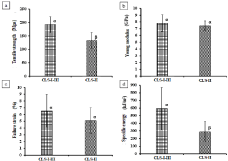
Figure 10: Strength (a), Young modulus (b), Failure strain (c), Specific
energy (d) of coconut leaf sheaths for each tensile loaded fibers direction
(CLS-I-III and CLS-II).
For each mechanical property, the averages of the two classes, CLS-I-III and
CLS-II, differ according the ANOVA and Tukey test at a 5% significance level
when the bars are topped by different symbols.
The tensile properties of coconut leaf sheaths, other native and man-made textiles studied or already used as composites reinforcements are gathered in Table 3. Comparing datas, coconut leaf sheaths show, in both tested directions, a better strength, a higher Young modulus and a greater failure strain than plant textiles reinforcements, whether they are native or man-made; except for flax, jute and hemp fabrics which are as ductile as coconut textiles for some directions (weft for flax and jute fabrics and warp for hemp fabric) and more ductile for the others directions. In addition, coconut leaf sheaths, mainly in fibers direction of layers I and III, present a tensile strength comparable to this of some commercialized glass fabric reinforcements such as HexForce 1658 and HexForce 4180.
Origin
Textile structure
Loaded direction
Strength (MPa)
Young modulus (GPa)
Failure strain (%)
References
Native Textiles
Plant Textiles
Coconut leaf sheath
Bidirectional : Biaxial braid + sewn fibers
CLS-I-III
193±30
7.8±1.2
6.5±2.4
Present study
CLS-II
133±30
7.4±0.7
5.1±1.9
Tururi (Manicaria saccifera)
Unidirectional
Fibers direction
18±8
0.6±0.3
5.9±1.0
[70]
71
2.2
5.3
[60]
Ashok (Polyalthia cerasoides)
Unidirectional
Fibers direction
44
3.5
2.5
[71]
Daalibuda (Hildegardia populifolia)
Unidirectional
Fibers direction
76
3.1
2.5
[72]
Karaya (Sterculia urens)
Unidirectional
Fibers direction
10
0.6
2
Dhaman (Grewia tilifolia)
Unidirectional
Fibers direction
65
4.5
1.6
[73]
Indian cherry tree (Cordia dichotoma)
Unidirectional
Fibers direction
17±1
2.2±0.1
1.4±0.1
[74]
Man-made textiles
Flax
Bidirectional : Woven
Warp
33
0.5
17.7
[75]
Weft
41
1
7.1
Jute
Bidirectional : Woven
Warp
57
-
10.4
[76]
Weft
89
-
5.2
Hemp
Bidirectional : Plain woven
Warp
22
0.5
9.3
[77]
Weft
25
0.5
11.2
Glass (commercial name : HexForce 1658)
Bidirectional : Plain woven
Warp
175
-
-
[78]
Synthetic textiles
Weft
175
-
-
Glass (commercial name : HexForce 4180)
Bidirectional : 4 Satin
Warp
164
-
-
Weft
219
-
-
Glass (commercial name : HexForce 7725)
Bidirectional : 2/2 twill
Warp
321
-
-
Weft
263
-
-
Table 3: Comparison of mechanical properties of coconut leaf sheaths and other plant and synthetic textile reinforcements tested in fibers/yarns directions.
Conclusion
This work contributes to the morphological, chemical, physical and mechanical characterizations of leaf sheath from Cocos nucifera L. to evaluate its potentiality as reinforcement in polymer matrix.
Coconut leaf sheath is a native bidirectional textile made of three unidirectional fibers layers, mainly composed of cellulose. The fibers of both layers are placed at 146o on average with the fibers of the third layer. They have an ellipsoidal shape and are consisted of a bundle of cells actually, bound together by the middle lamella.
Due to the presence of cavities and grained protusions on the fibers, coconut leaf sheath displays a rough surface, conducive to a better fiber/matrix interfacial adhesion improving penetration of polymers during composites manufacture.
Compared to classic plant polymeric reinforcements, the coconut sheath cellulosic elements are embedded in a matrix richer in hemicelluloses, highly hydrophilic and in lignins, limiting the load transfer to cellulose fibrils. These components may be removed in greater or lesser extent, applying treatments to the lignocellulosic fibers.
Coconut leaf sheath is more lightweight than popular natural and synthetic fibers commonly used to reinforce composites and is less hydrophilic than hemp, sisal, jute, banana and kenaf, which should increase durability of coconut leaf sheath reinforced composites.
The processing temperature of coconut leaf sheath reinforced polymers is restricted to temperatures below 220oC, its onset decomposition temperature.
For both tested fibers directions, coconut leaf sheath shows competitive tensile properties, better than most natural native and man-made textiles reinforcements, and as good as some synthetic glass fabrics reinforcements. Coconut leaf sheath tested in fibers directions of layers I and III presents better strength and toughness than these obtained in fibers directions of layer II.
Acknowledgement
The authors thank for the financial support (1) the Région Guadeloupe, (2) the Agence Nationale de la Recherche for the project AWaPUMat/Résidus industriels, leurs usages potentiels comme matériaux pour l’habitation et la construction no ANR-12- ISO9-0002-01 and (3) and Christian Gauss (FZEA USP) for the mechanical tests.
References
- Landrigan PJ, Fuller R, Acosta NJR, Adeyi O, Arnold R, Basu N, et al. The Lancet commission on pollution and health. The Lancet. 2018; 391: 462-512.
- Melgar-Melgar RE, Hall CASE. Why ecological economics needs to return to its roots: The biophysical foundation of socio-economic systems, Ecological Economics. 2020; 169: 106657.
- Vaisanen T, Das O, Tomppo L. A review on new bio-based constituents for natural fiber-polymer composites. J. Clean. Prod. 2017; 149: 582-596.
- Rodier L, Bilba K, Onésippe C, Arsène MA. Utilization of bio-chars from sugarcanne pyrolyis in cement-based composites. Ind. Crops Prod. 2019; 141: 111731.
- Sonar T, Patil S, Deshmukh V, Acharya R. Natural Fiber Reinforced Polymer Composite Material-A Review. IOSR J. Mech. Civil Eng. 2015; 142-147.
- Pickering KL, Efendy MGA, Le TM. A review of recent developments in natural fibre composites and their mechanical performance. Comp. A Appl. Sci. Manufact. 2016; 83: 98-112.
- Fogorasi MS, Barbu I. The potential of natural fibres for automotive sectorreview. IOP Conference Series: Materials Science and Engineering. 2017; 252: 012044.
- Mohamed SAN, Zainudin ES, Sapuan SM, Azaman MD, Arifin AMT. Introduction to Natural Fiber Reinforced Vinyl Ester and Vinyl Polymer Composites. Sapuan SM, Ismail H, Zainudin ES, editors. In: Natural Fibre Reinforced Vinyl Ester and Vinyl Polymer Composites, Woodhead Publishing. 2018; 1-25.
- Mochane MJ, Mokhena TC, Mokhothu TH, Mtibe A, Sadiku ER, Ray SS, et al. Recent progress on natural fiber hybrid composites for advanced applications: A review, Express Polym. Lett. 2019; 13: 159-198.
- Abdollah MFB, Salim MAB, Tuan TB. Proceedings of Mechanical Engineering Research Day 2016. Centre for Advanced Research on Energy. Malaysia. 2016.
- Zhou YG, Su B, Turng LS. Mechanical properties, fiber orientation, and length distribution of glass fiber-reinforced polypropylene parts: Influence of waterfoaming technology. Polym. Comp. 2018; 39: 4386-4399.
- Such M, Ward C, Potter K. Aligned Discontinuous Fibre Composites : A Short History. J. Multifunct. Comp. 2014; 3: 155-168.
- Goutianos S, Peijs T, Nystrom B, Skrifvars M. Development of Flax Fibre based Textile Reinforcements for Composite Applications. Appl. Comp. Materials. 2006; 13: 199-215.
- Mallick PK. Thermoplastics and thermoplastic-matrix composites for lightweight automotive structures. Mallick PK, editors. In: Materials, Design and Manufacturing for Lightweight Vehicles. Woodhead Publishing. 2010; 174-207.
- Porras A, Maranon A. Development and characterization of a laminate composite material from Polylactic Acid (PLA) and woven bamboo fabric. Comp. B Eng. 2012; 43: 2782-2788.
- Jeyanthi S, Janci J. Development of natural long fiber thermoplastic composites for automotive frontal beams. Indian J. Eng. Materials Sci. 2014; 21: 580-584.
- Sunny T, Pickering KL, Lim SH. Alignment of Short Fibres : An Overview. Bickerton S, Lin RJT, Somashekar AA, Singh I, Srivatsan TS, editors. In: Processing and Fabrication of Advanced Materials - XXV. Auckland, New Zealand. 2017; 616-625.
- Tambyrajah D. Indulge & Explore Natural Fiber Composites: An Invitation to Product Designers, Netherlands Enterprise Agencies. 2015.
- Matveev MY, Long AC. Numerical modelling for predicting failure in textile composites. Camanho PP, Hallett SR, editors. In: Numerical Modelling of Failure in Advanced Composite Materials. Woodhead Publishing. 2015; 435- 455.
- Karaduman NS, Karaduman Y, Ozdemir HO. Textile Reinforced Structural Composites for Advanced Applications. Textiles for Advanced Applications. 2017.
- Pascal F, Dorival O, Navarro P, Marguet S, Ferrero JF. Impact damage prediction in thin woven composite laminates - Part I: Modeling strategy and validation. Comp. Struct. 2018; 190: 32-42.
- Bachtiar EV, Kurkowiak K, Yan L, Kasal B, Kolb T. Thermal Stability, Fire Performance, and Mechanical Properties of Natural Fibre Fabric-Reinforced Polymer Composites with Different Fire Retardants. Polymers. 2019; 11: 699- 714.
- Osswald TA. Discontinuous fiber composites. 2019.
- Anandjiwala RD. Textiles for Sustainable Development. Nova Publishers. USA. 2007.
- FAO. FAOSTAT. 2019.
- Chan E, Elevitch CR. Cocos nucifera (coconut), Species Profiles for Pacific Island Agroforestry. Permanent Agriculture Resources. Version 2.1. 2006.
- Ouensanga A, Picard C. Thermal degradation of sugar cane bagasse. Thermochimica Acta. 1988; 125: 89-97.
- ASTM D5035. Standard Test Method for Breaking Force and Elongation of Textile Fabrics (Strip Method). 2015.
- Denninger D, Berger M, Kyosev Y. Interlacement Variations in the Alternative Covering Technology D-3F. Kyosev Y, Mahltig B, Schwarz-Pfeiffer, editors. In: Narrow and Smart Textiles. Springer International Publishing. Cham. 2018; 69-79.
- Muraille L, Aguié-Béghin V, Chabbert B, Molinari M. Bioinspired lignocellulosic films to understand the mechanical properties of lignified plant cell walls at nanoscale. Scientific reports. 2017; 7: 44065.
- Vo LTT, Navard P. Treatments of plant biomass for cementitious building materials – A review. Constr. Build. Mat. 2016; 121: 161-176.
- Hao LC, Sapuan SM, Hassan MR, Sheltami RM. Natural fiber reinforced vinyl polymer composites. Sapuan SM, Ismail H, Zainudin ES, editors. In: Natural Fibre Reinforced Vinyl Ester and Vinyl Polymer Composites. Woodhead Publishing. 2018; 27-70.
- Ikramullah, Rizal S, Gopakumar DA, Thalib S, Huzni S, Abdul Khalil HPS. Interfacial Compatibility Evaluation on the Fiber Treatment in the Typha Fiber Reinforced Epoxy Composites and Their Effect on the Chemical and Mechanical Properties. Polymers. 2018; 10: 1-13.
- Brigham C. Biopolymers: Biodegradable Alternatives to Traditional Plastics. Török B, Dransfield T, editors. In: Green Chemistry. Elsevier. 2018; 753-770.
- Zeng Y, Himmel ME, Ding SY. Visualizing chemical functionality in plant cell walls. Biotechnol. Biofuels. 2017; 10: 263-279.
- Bledzki AK, Letman M, Viksne A, Rence L. A comparison of compounding processes and wood type for wood fibre-PP composites. Comp. A: Appl. Sci. Manufact. 2005; 36: 789-797.
- Abouzeid R, El-Wakil N, Fahmy Y. Thermoplastic Composites from Natural Reed Fibers. Egyptian J. Chem. 2015; 58: 287-298.
- Raharjo P, Soenoko R, Purnowidodo A, Choiron M. Characterization of Sodium-Bicarbonate-Treated Zalacca Fibers as Composite Reinforcements. Evergreen. 2019; 6: 29-38.
- Özparpucu M, Rüggeberg M, Gierlinger N, Cesarino I, Vanholme R, Boerjan W, et al. Unravelling the impact of lignin on cell wall mechanics: a comprehensive study on young poplar trees downregulated for CINNAMYL ALCOHOL DEHYDROGENASE (CAD). Plant J. Cell Molecul. Biol. 2017; 91: 480-490.
- Ramasawmy H, Chummun J, Bhurtun AB. Characterization of the tensile strength of chemically treated Pandanus utilis (screwpine) fibres for potential application as reinforcement in epoxy composite. Int. J. Plastics Technol. 2017; 21: 144-170.
- Lu N, Oza S, Tajabadi M. Surface Modification of Natural Fibers for Reinforcement in Polymeric Composites. John Wiley & Sons, editors In: Surface Modification of Biopolymers. 2015; 224-237.
- Koohestani B, Darban AK, Mokhtari P, Yilmaz E, Darezereshki E. Comparison of different natural fiber treatments: a literature review. Int. J. Environm. Sci. Technol. 2019; 16: 629-642.
- Jones D, Ormondroyd GO, Curling SF, Popescu CM, Popescu MC. Chemical compositions of natural fibres. Fan M, Fu F, editors. In: Advanced High Strength Natural Fibre Composites in Construction. Woodhead Publishing. 2017; 23-58.
- Parida C, Dash SK, Pradhan C. FTIR and Raman Studies of Cellulose Fibers of Luffa cylindrical. Open J. Comp. Materials. 2015; 5: 5-10.
- Anandarajah C, Li P, Michel M, Chen Y, Jamshidi R, Kiziltas A, et al. Study of Agave Fiber-Reinforced Biocomposite Films. Materials. 2018; 12: 99-111.
- Salem IAS, Rozyanty AR, Betar BO, Adam T, Mohammed M, Mohammed AM. Study of the effect of surface treatment of kenaf fiber on chemical structure and water absorption of kenaf filled unsaturated polyester composite. J. Phys. Conference Series. 2017; 908: 012001.
- Wolela AD. Extraction and Characterization of Natural Cellulose Fibers from Sansevieria Trifasciata Plant. Advancem. Bioequ. Bioavailab. 2019; 5: 630- 634.
- De Lemos AL, Santana R, Mauss C. Characterization of natural fibers: Wood, sugarcane and babassu for use in biocomposites. Cellulose Chem. Technol. 2017; 51: 711-718.
- Alomayri T, Assaedi H, Shaikh FUA, Low IM. Effect of water absorption on the mechanical properties of cotton fabric-reinforced geopolymer composites. J. Asian Ceramic Soc. 2014; 2: 223-230.
- Wang H, Lin F, Qiu P, Liu T. Effects of Extractives on Dimensional Stability, Dynamic Mechanical Properties, Creep, and Stress Relaxation of Rice Straw/ High-Density Polyethylene Composites. Polymers. 2018; 10: 1176-1186.
- Ornaghi HL, Poletto M, Zattera AJ, Amico SC. Correlation of the thermal stability and the decomposition kinetics of six different vegetal fibers. Cellulose. 2014; 21: 177-188.
- Jain J, Jain S, Sinha S. Characterization and thermal kinetic analysis of pineapple leaf fibers and their reinforcement in epoxy. J. Elast. Plastics. 2019; 51: 224-243.
- Hart A, Summerscales J. Effect of time at temperature for natural fibres. Procedia Eng. 2017; 200: 269-275.
- Monteiro SN, Calado V, Rodriguez RJS, Margem FM. Thermogravimetric behavior of natural fibers reinforced polymer composites - An overview. Materials Sci. Eng. A. 2012; 557: 17-28.
- Poletto M, Jünior HLO, Zattera AJ. Thermal Decomposition of Natural Fibers: Kinetics and Degradation Mechanisms. John Wiley & Sons, editors. In: Reactions and Mechanisms in Thermal Analysis of Advanced Materials. 2015; 515-545.
- Yao F, Wu Q, Lei Y, Guo W, Xu Y. Thermal decomposition kinetics of natural fibers: Activation energy with dynamic thermogravimetric analysis. Polym. Degradation Stability. 2008; 93: 90-98.
- Yang H, Yan R, Chen H, Lee DH, Zheng C. Characteristics of hemicellulose, cellulose and lignin pyrolysis. Fuel. 2007; 86: 1781-1788.
- Poletto M. Assessment of the thermal behavior of lignins from softwood and hardwood species. Maderas: Ciencia y tecnología. 2017; 19: 63-74.
- Patel JP, Parsania PH. Characterization, testing, and reinforcing materials of biodegradable composites. Shimpi NG, editors. In: Biodegradable and Biocompatible Polymer Composites. Woodhead Publishing. 2018; 55-79.
- Porras A, Maranon A, Ashcroft IA. Characterization of a novel natural cellulose fabric from Manicaria saccifera palm as possible reinforcement of composite materials. Comp. B Eng. 2015; 74: 66-73.
- Chandrasekar M, Ishak MR, Sapuan SN, Leman Z, Jawaid M. A review on the characterization of natural fibres and their composites after alkali treatment and water absorption. Polymers Adv. Technol. 2017; 46: 119-136.
- Pai A, Jagtap RN. Surface morphology & mechanical properties of some unique natural fiber reinforced polymer composites-a review. J. Materials Env. Sci. 2015; 6: 902-917.
- Yildizhan S, Çalik A, Özcanli M, Serin H. Bio-composite materials: a short review of recent trends, mechanical and chemical properties, and applications. European Mechan. Sci. 2018; 2: 83-91.
- Magniont C. Contribution à la formulation et à la caractérisation d’un écomatériau de construction à base d’agroressources. 2010.
- Agopyan V, Savastano Junior H, John VM, Cincotto MA. Developments on vegetable fibre–cement based materials in São Paulo, Brazil: an overview. Cem. Concr. Comp. 2005; 27; 527-536.
- Tolêdo Filho RD, Ghavami K, Sanjuán MA, England GL. Free, restrained and drying shrinkage of cement mortar composites reinforced with vegetable fibres. Cem. Concr. Comp. 2005; 27: 537-546.
- Ramakrishna G, Sundararajan T. Impact strength of a few natural fibre reinforced cement mortar slabs: a comparative study. Cem. Concr. Comp. 2005; 27: 547-553.
- Pacheco-Torgal F, Jalali S. Cementitious building materials reinforced with vegetable fibres: A review. Constr. Build. Mat. 2011; 25: 575-581.
- Kriker A, Debicki G, Bali A, Khenfer MM, Chabannet M. Mechanical properties of date palm fibres and concrete reinforced with date palm fibres in hot-dry climate. Cem. Concr. Comp. 2005; 27: 554-564.
- Pennas L, Cattani I, Leonardi B, Seyam AF, Midani M, Sousa Monteiro A, et al. Textile Palm Fibers from Amazon Biome. Materials Res. 2019; 11: 262- 274.
- Jayaramudu J, Reddy DJP, Guduri BR, Rajulu AV. Properties of natural fabric polyalthia cerasoides. Fibers Polym. 2009b; 10: 338-342.
- Jayaramudu J, Guduri BR, Rajulu AV. Characterization of Natural Fabric Sterculia urens. Int. J. Polym. Anal. Charact. 2009a; 14: 115-125.
- Jayaramudu J, Guduri BR, Varada Rajulu A. Characterization of new natural cellulosic fabric Grewia tilifolia. Carb. Polym. 2010; 79: 847-851.
- Jayaramudu J, Maity A, Sadiku ER, Guduri BR, Varada Rajulu A, Ramana CHVV, et al. Structure and properties of new natural cellulose fabrics from Cordia dichotoma. Carb. Polym. 2011; 86: 1623-1629.
- Chabba S, Netravali AN. “Green” composites Part 1: Characterization of flax fabric and glutaraldehyde modified soy protein concentrate composites. J. Materials Sci. 2005; 40: 6263-6273.
- Hamza B, ElHaddi H, Mansour R, Priniotakis G, Vassilliadis S, Vasilakos S, et al. Physico-chemical and mechanical characterization of Jute fabrics for civil engineering applications. J. Comput. Methods Sci. Eng. 2018; 18; 1-19.
- Misnon IM, Islam MM, Epaarachchi JA, Lau KT, Wang H. Fabric Parameter Effect on the Mechanical Properties of Woven Hemp Fabric Reinforced Composites as an Alternative to Wood Products. Adv. Res. Textile Eng. 2016; 1: 1-11.
- Renforts tissés. Hexcel. 2019.
